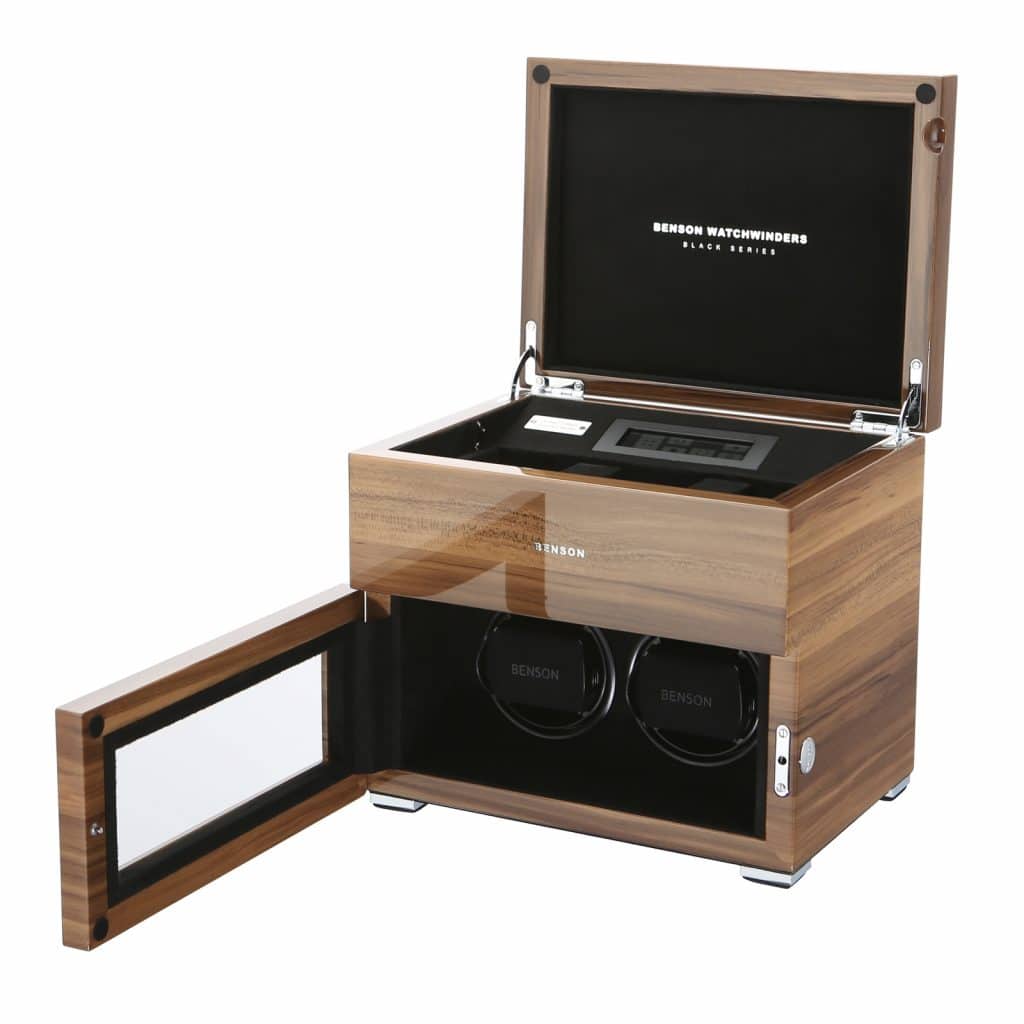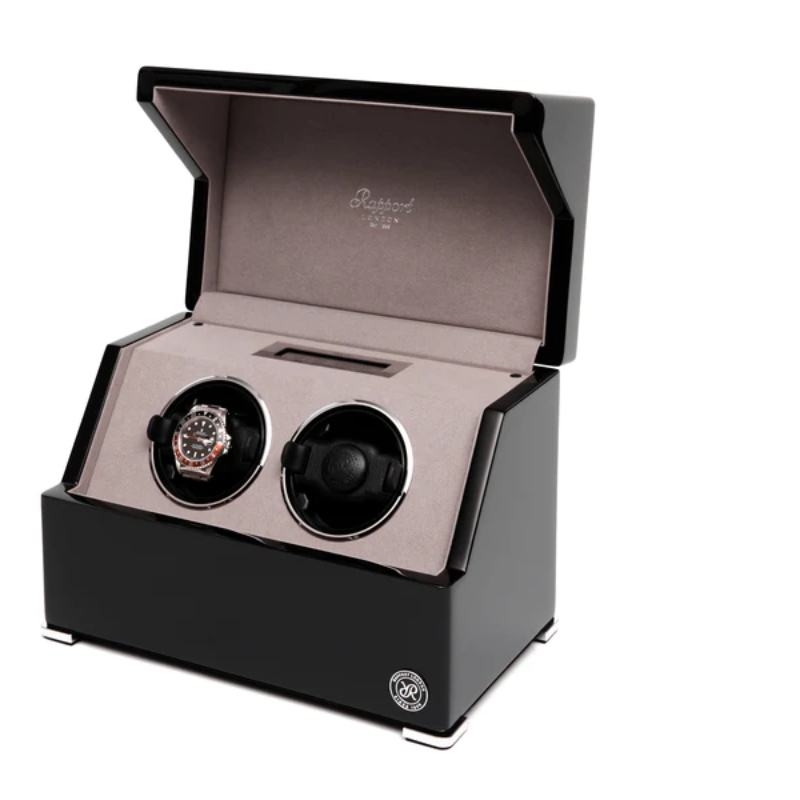What Type Of Watch Winder Do I Need?
Before buying a new watch winder, there are a number of things you need to think about in order to make the right decision.
Consider the various features of your automatic watch to start with.
Which direction does the rotor wind the mainspring?
It could be clockwise, counter-clockwise or even what we call bi-directional.
Then there’s the “turns per day” which is essentially knowing the amount of turns the rotor makes as it keeps your watch fully wound.
Let’s have a look at a couple of specific examples of what we’ve mentioned so far.
ROLEX COSMOGRAPH DAYTONA
The movement inside the Daytona 116520 is Rolex’s own 4130 caliber. The rotor on this particular movement needs between 650-800 turns per day in order to stay fully wound – that’s 37 turns in an hour. The rotor itself can be turned in any direction to be wound.
So, a winder for this watch will need to be able to match the aforementioned performance. If you have a non-programmable watch winder that can turn both ways, it will need to be able to deliver 1800 turns per day as half of them simply won’t wind the watch.
THE ROLEX SUBMARINER
With the Rolex 3135 caliber in situ, the Submariner, like the Daytona, has a bi-directional winding rotor. However, the lower end of the Daytona’s requirement (650 turns per day or 27 turns per hour) is enough for the Submariner.
This watch is also a little more versatile when it comes to choosing a winder, largely thanks to the bi-directional movement. As most watch winders are capable of turning the requisite 650 turns, most are perfectly suitable for the Rolex Submariner, even those that are not programmable.
WHAT SHOULD I KNOW ABOUT MY WATCH WINDER?
We’ve had a quick look at the various functions of the watches themselves but what about the winders? Can you program the turning direction? Can you set the winder so that it only winds a set amount of times?
What about the weight of your watch? Some can be particularly heavy, so will the winder be able to take the weight without effecting performance, especially if the winder you are thinking about is particularly light? Will a large watch even fit into your chosen winder?
You’ll also need to consider the different kinds of power sources: DC = battery powered and AC = plugs into the mains.
Looking for a new watch winder? Browse our range here.
WHAT ARE THE BENEFITS OF A PROGRAMMABLE WINDER?
There are two absolutely essential elements to a winder: the number of turns per day and the winder direction itself (clockwise etc.).
A programmable model will allow you to set or program at least one of these features and very often both.
If you are thinking about selecting a winder that features more than one head, we would recommend that you select one where you can program each head individually. There are also winders available where a group of heads can be programmed.
CHOOSING A WINDER
Although not an absolute requirement, a watch winder is a very useful accessory for those that collect or love watches. In fact, the more watches you have – and intend to wear – the more essential a winder becomes. Most collectors find a winder to be a very sound investment, so it’s worth working out what you need ahead of time.
There is also an array of choice when it comes to the cosmetic appearance of your winder – you could opt for something relatively simple if it’s purely the functionality you require and these options invariably work out less expensive.
However, if you are looking for a little more luxury, there really are plenty of choices but be aware that generally with increased style comes an increased price.
We’ve already briefly mentioned winders that feature multiple heads – these are particularly useful for avid collectors and watch wearers as it enables you to cycle through multiple watches and always have one perfectly ready to wear.
YOU’VE GOT THE POWER
So, the next main consideration is the power source. Do you opt for AC or DC powered winder?
AC – A watch winder powered by AC will need a power cable that plugs into the mains. There a couple of pros and cons here. The fact that you need a cable and a mains socket does mean that there is a limit to where you can display your winder. On the other hand, there’s perhaps a practical benefit for those seeking to buy a winder with multiple heads.
DC – You won’t need a power cable with a DC powered winder, just the required battery or batteries. Of course, it all boils down to personal choice but from a practical point of view, this particular option is perhaps safer in terms of storage and more practical in terms of mobility. If you need to store your winder in a safe, then this would seem a more sensible option.
WATCH WINDERS FAQS
We frequently get asked similar questions in our showroom. Whether you are looking to buy WOLF, Rapport or Swiss Kubik watch winders, the below questions are necessary to know.
CAN YOU OVERWIND AN AUTOMATIC WATCH?
This is a frequently asked question and the simple answer is a resounding NO. You can’t overwind an automatic watch but there are a few things that are worth noting.
So, once the mainspring has been fully wound, the gears that do the winding actually disengage or detach from the movement, preventing the over winding in question.
Good watches are very hardy so have no problem with constant motion but it may be sensible to get a programmable winder suited to a particular watch or watches. This way, you can ensure that the watch only gets wound as much as is required.
You don’t really want to end up in a situation where your watch is being wound almost 2000 times a day when it actually only needs around 650 turns per day, resulting in unnecessary wear and tear. A few extra winds though won’t harm your watch at all.
WILL IT CAUSE ANY DAMAGE IF MY WATCH IS CONSTANTLY RUNNING?
Anything that runs all the time is going to be more susceptible to wear and tear but any damage to a watch is likely to be extremely minimal.
A watch by its very design is something intended to be running all the time and worn a lot of the time, so wearing a watch every day is only really using it as it was intended. So any extra stress on the mechanisms is very small.
In fact, some watches are much more likely to benefit from constant running – such as one that uses a perpetual calendar, for example, which would otherwise need resetting when the watch stops.
WILL A WATCH ON A WINDER BE LESS ACCURATE?
It’s fair to say that manufacturers of watches and clocks often pride themselves on the accuracy of their time keeping devices but there’s some very basic science that will always prevent absolute accuracy, especially for a watch on a winder.
The force of gravity actually causes a drag effect on the escapement wheel in the watch and this results in variations in speed, faster when the watch is in some positions and slower in others. How a watch overcomes this problem is thanks to the small regulating weights that are fitted to the balance wheel – enabling the watch to speed up or slow down as required.
Across the duration of the day, the deficit in accuracy is more or less cancelled out. Because a watch on a winder will only be in a single position, rather than the multiple positions of a wrist worn watch, it’s reasonable to assume that the watch on the winder will in fact be a little less accurate.
The difference will be so slight and is completely outweighed by the advantages of using a watch winder.
3 Amazing Watch Winders
-
Benson Black Series Double Watch Winder – Walnut
£639.00
Availability: Usually Ships Within 7 Working Days
-
Rapport Perpetua III Duo Watch Winder Touch Screen – Black
£935.00
Availability: In Stock - Ready To Ship


















